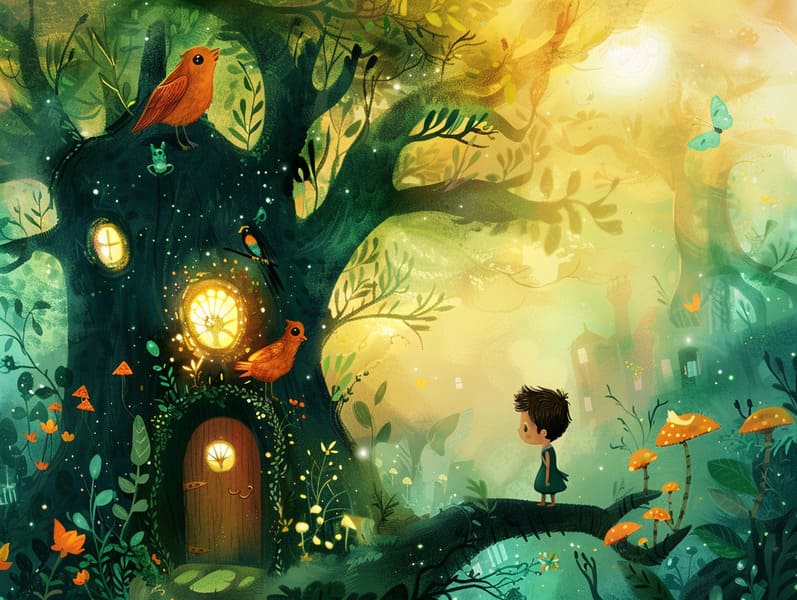
Old fairy tales have ancient roots. These narratives have been whispered from one generation to the next long before they were ever documented. They emerged from a variety of backgrounds, including African traditions. They were initially shared among older generations, often carrying themes and messages mirroring the societal norms and beliefs of the time.
Jacob and Wilhelm Grimm, Jacob and Wilhelm (the Grimm brothers), were among the first to compile and publish many of these beloved fairy tales. Their anthology, "Grimm's Fables," included stories like "Ashenputtel," "Little Brother and Little Sister," and "Schneewittchen," which have since become staples in the world of timeless fairy tales. Similarly, Hans Christian Andersen's delightful tales, such as "The Story of the Little Mermaid," and "The Duckling that Could," have won hearts worldwide, guaranteeing their place in the pantheon of classic fairy tales.
Even though they are old, these tales remain as applicable as ever, especially as bedtime stories for kids. These magical stories are now available in diverse formats, including vibrantly illustrated books, captivating animations, and digital fairy tales.
Their continued relevance can be linked to several magical reasons:
Significant Morals: Classic fairy tales often illustrate important moral lessons. Tales like "The Boy Who Cried Wolf" teach the merit of truth, while "The Race of the Tortoise and the Hare" demonstrate the values of determination and meekness. These tales offer young ones clear distinctions between truth and falsehood, building their moral compass in a gentle yet impactful way.
Empathy and Understanding: Old fairy tales frequently include figures facing trials and tribulations, stimulating readers to feel with their struggles and support their triumphs. For instance, "The Tale of Beauty and the Beast" points out the significance of looking beyond appearances to see the inner core of a being, developing tenderness and discernment.
Cultural Appreciation: Many ancient fairy tales are steeped in the cultural contexts from which they sprang. Learning from these fairy tales can provide fascinating glimpses into different social structures, advancing a sense of global respect and acknowledgment.
Inventiveness and Imagination: The fanciful elements in fairy tales—wizardry and magic—engender children’s imaginations. These tales transport readers to fantastical realms, activating imaginative ideas and a sense of magic that remains a lifetime.
Classic fairy tales are not only alluring but also instructive. They serve as bewitching tools in fostering various thinking and feeling skills in the young. When ancient fairy tales are told out loud, they foster language skills by click here offering new linguistic elements and intricate sentence structures. This practice also boosts hearing perception and focus, as kids stay focused, enthusiastic to see what happens next.
Furthermore, contemplating the themes and characters of fairy tales can develop logical thinking and problem-solving abilities. Little ones are shown to recognize patterns, make predictions, and make sense of cause and effect. These explorations also ease children communicate their thoughts and feelings, fostering their emotional intelligence.
In today’s digital era, the proliferation of free fairy tales online has made these narratives more obtainable than ever. Web-based platforms and programs supply vast collections of children's fairy tales that can be perused or listened on anytime, anywhere. Fairy tales read out loud are particularly sought after, offering an immersive method for young readers to experience these fantastical tales. Voice books and narrated videos lead characters and settings to life, often supplemented by captivating sound effects and songs that heighten the story journey.
The lasting allure of timeless fairy tales lies in their ability to adjust to present days while retaining their core messages. Contemporary reinterpretations of these fairy tales often feature more diverse protagonists and modern settings, making them understandable to today’s audience. However, the basic principles of fortitude, understanding, and lawfulness remain unchanged, continuing to appeal to children of all ages.
Old fairy tales also offer a sense of calm and comprehensibility. They showcase a methodical narrative with a clear beginning, middle, and end, often winding up with the wrap-up of conflicts and the triumph of good over evil. This reliability can be comforting for children, furnishing a sense of unwaveringness in an unstable world.
Timeless fairy tales continue to entrance and educate new generations, maintaining their captivation and importance in modern society. As kids' bedtime tales, they deliver up a perfect blend of charm and understanding, fostering moral values, empathy, and creativity. The existence of web-based fairy tales and the well-received status of fairy tales read out loud promise that these timeless tales remain reachable to new generations.
By safeguarding and distributing these narratives, we continue to exalt the rich tapestry of tales and cultural heritage. Whether you are experiencing a beautifully illustrated book, seeing a virtual library, or hearing an spoken story, the elegance of ancient fairy tales is always within reach. These tales show us of the unchanging nature of fairy tales and its ability to connect us across generations and cultures.
Be it you are reading a beautifully illustrated book, delving into a internet collection, or hearing an audio story, the delight of famous fairy tales is always within reach.
These narratives illustrate of the endless presence of tales and its ability to unify us across centuries and lands, casting a charm that charms and informs alike.
Comments on “The Rise of Bedtime Fairy Tales with Their Steadfast Wonder.”